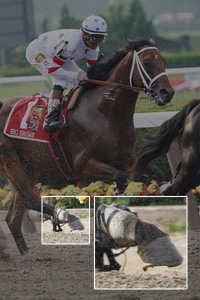 There's something about the bike, along with the chair, that draws designers. Despite being an almost perfect design already, the reworkings of the humble bicycle seem almost endless. Some are genuine improvements, such as the change from pedals fixed to the front wheel (Penny Farthing) to a rod or chain driving the rear wheel, and others are less so (low-riders, anyone?)
There's something about the bike, along with the chair, that draws designers. Despite being an almost perfect design already, the reworkings of the humble bicycle seem almost endless. Some are genuine improvements, such as the change from pedals fixed to the front wheel (Penny Farthing) to a rod or chain driving the rear wheel, and others are less so (low-riders, anyone?) You wouldn't think that much more could be done to the basic diamond-framed, two-wheeled approach, but those designers can' stop fiddling. Here are some of the fruits of their labors.
Above: A bike with square wheels may look impractical, but it would actually be ridable -- on a highway that is surfaced with a series of inverted catenaries.
Photo: vrogy/Flickr

Pilen Concept
This one makes it into the list because it looks so cool. Based on 1930s Le Mans racing bikes, the Pilen Concept is designed by Eric Therner for Swedish company Pilen Bikes. Is might look retro, but hidden behind the styling is a lot of high-tech gear. LED lights are built in to the frame and the saddle is in two parts for independent shock absorption.
Oddly, despite having two brake levers, the Pilen doesn't seem to have a front brake. And the nonadjustable seat height could be a problem, too. But who cares when it looks this good?
Pilen Concept product page [Addi via Design Boom]
 Cube Urban Street Concept
Cube Urban Street ConceptThis bike, despite its looks, is a folder, squishing down to a backpack-sized collection of carbon fiber rods and tubes. You'll still need to find somewhere to put the wheels, but once that's done, you have another pretty theft-proof design. And it's just as well. Carrying a lock would probably treble the weight of the bike.
Cube's Collapsible Carbon Concept Cycle [Gadget Lab]

Cardboard Bike
The idea behind design student Phil Bridge's concept is that it is theft-proof: Nobody would steal a cardboard bike. And if they do, it'll only cost $30 to buy a new one. This isn't any old cardboard -- it's hexacomb cardboard, a tough material used in the packing industry which can be foil-faced for waterproofing.
Bridge says that the bike should last for around six months in normal use, and the non-card parts can simply be reused on the next one. We do wonder, though, how the high-stress components will do. I've been through plenty of cranks in the past, for example, and those were made of metal.
Design Student Produces $30 Cardboard Bike [Quickrelease via Bicycle Design]
 Puma Bike
Puma BikeThe Puma isn't a concept bike, since you can actually buy one, but it's definitely in the spirit of the weird and wonderful. It's Puma Bike is a single-geared bike with dual-disk brakes.
The central conceit is the cable replacing one section of the frame (the down tube), which renders it pretty much theft-proof. The idea is this: You remove the cable and use it to lock the (now-folded) bike. If a thief cuts the cable, he can't ride off on the bike. Simple and almost worthy of Alexander the Great in it's ingenuity (Alex was the Gordian knot guy).
While we've covered the Puma bike before (in its Glow-Rider guise) we've never tested one, so we can't confirm our fear that that cable-strung frame will be a little mushy and wobbly to ride. €1100 ($1700).
Puma Bike product page [Puma]
 The Ride
The RideEllsworth Bicycle's "The Ride" is another bike you can actually purchase, if you've got the dough; but it deserves a place in this lineup for its crazy transmission. Instead of using a fixed number gears, The Ride's "continuously variable planetary drive" offers an infinitely variable drive ratio. As you twist a dial on the handlebar, it changes the angle between two steel plates in the hub, adjusting the torque. The design was first envisioned by Leonardo da Vinci in the 1490s, and it can be yours for a mere $3,000.
Original here









